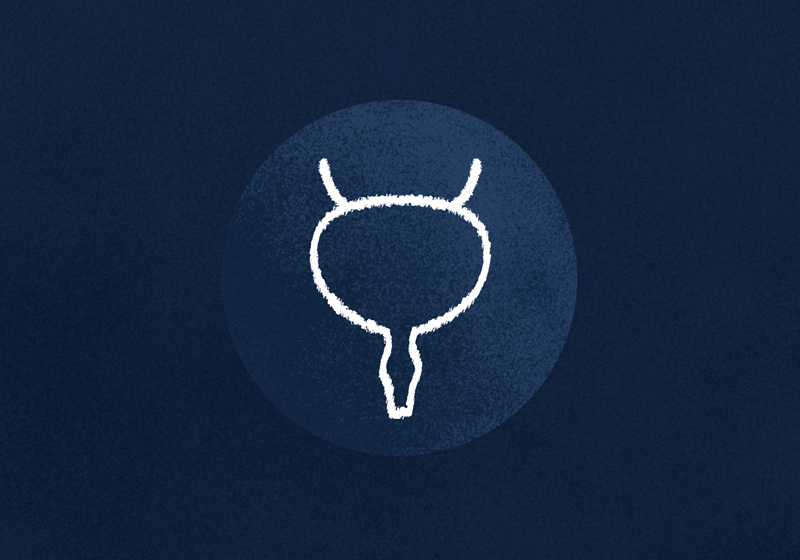Bladder Cancer

What is the function of the bladder?
Your bladder is a remarkable organ that is crucial to your urinary system. It’s a hollow, muscular organ located in your pelvis. The bladder’s primary function is to store and release urine, a waste product your kidneys produce.
What is bladder cancer?
Bladder cancer develops when abnormal cells within the bladder multiply uncontrollably, forming tumours. These tumours can be either non-invasive, staying within the inner lining, or invasive, penetrating deeper bladder layers.
What are the symptoms of bladder cancer?
Bladder cancer may present with subtle symptoms, but it’s crucial to be aware of them. Common symptoms include:
- Blood in Urine (Haematuria): This is often the first noticeable sign, visible or detected during a urine test.
- Frequent Urination: An increased need to urinate, especially at night.
- Pain or Burning Sensation: Discomfort during urination.
- Bone or Pelvic Pain: these symptoms are uncommon.
What are the causes of bladder cancer?
While the precise cause of bladder cancer isn’t always clear, certain factors may elevate your risk:
- Tobacco Use: Smoking is a significant risk factor for bladder cancer.
- Age: The risk increases with age, with most cases occurring in people over 55.
- Chemical Exposures: Prolonged exposure to certain chemicals, such as workplace exposure, may increase risk. These industries include paint, tyre, metal, dye and petrol processing plants.
- Radiation: previous radiation to the pelvis is associated with an increased lifetime risk.
- Previous Cyclophosphamide: a chemotherapy agent
- Family History: A family history of bladder cancer may contribute to a higher risk.
How is bladder cancer diagnosed?
Early detection is critical to effective bladder cancer management. Your doctor may use various tests, including:
- Urine Cytology: This series (x3) of specialised urine tests helps detect cancer cells. Urine samples are collected over three days (discarding the first urine in the morning) and stored in the fridge until all three samples are taken to the pathology centre for analysis.
- Cystoscopy: A slender tube with a camera is inserted into the bladder for a close examination under local anaesthesia or sedation.
- Biopsy: A small sample of bladder tissue is taken to examine for cancer cells.
- Imaging Tests: CT scans (with contrast), MRIs, or ultrasounds provide detailed images to assess the extent and location of cancer.
Prompt diagnosis enables the creation of a personalised treatment plan tailored to your needs.
What are the grades and stages of bladder cancer?
The strongest predictors for bladder cancer outcome are categorised by grade and stage, influencing treatment options:
Grades:
- Low Grade (G1): These cancers tend to grow slowly and are less likely to invade deeper layers.
- High Grade (G2 or G3): More aggressive cancers with a higher likelihood of spreading.
Stages:
- Non-Invasive (Stage Ta or CIS): Limited to the bladder’s inner lining.
- Invasive (Stages I-IV): Cancer has penetrated deeper layers and is at high risk of spreading to nearby organs or distant body parts.
Treatment plans are tailored based on these factors and the patient’s condition.
How is bladder cancer treated?
Bladder cancer treatment considers stage, grade, and overall health factors. Common treatment options include:
- Transurethral Resection of Bladder Tumor (TURBT): A minimally invasive procedure performed by cystoscopy. Special instruments are passed through the telescope to remove any tumours. TURBT is frequently curative, especially for non-invasive or superficial bladder cancers. An overnight hospital stay may be required with a short-term urinary catheter.
- Cystectomy: This surgical procedure is often considered for advanced or aggressive bladder cancer. During a cystectomy, part of or the entire bladder is removed to eliminate invasive cancer. If the whole bladder is removed, a new reservoir is reconstructed using small intestine to create an external conduit and stoma (ileal conduit) or an internal reservoir (neobladder). Robotic cystectomy is a common surgical approach that minimises inpatient stay and blood loss.
- Immunotherapy: Enhancing the immune system to combat cancer cells. This is given directly into the body or instilled through the bladder over several visits.
- Chemotherapy: Medications to kill or inhibit the growth of cancer cells. This may be a single dose into the bladder after a procedure such as TURBT or multiple doses to minimise the recurrence of bladder cancer. Whole-body chemotherapy may be used for more invasive cancer.
- Radiation Therapy: High-energy rays targeting and shrinking tumours are often used with chemotherapy.
- Intravesical Therapy: Medications delivered directly into the bladder are chemotherapy or immunotherapy agents. A commonly used immunotherapy is BCG.
Understanding BCG
Intravesical Bacillus Calmette-Guérin, commonly known as BCG, is a specialised treatment for treating certain types of bladder cancer. Unlike traditional cancer treatments, BCG is a form of immunotherapy that harnesses the power of your body’s immune system to combat cancer cells.
It is administered directly into the bladder through a catheter. The BCG solution is held in the bladder for a specified period, usually around one to two hours, allowing the medication to interact with the bladder wall. Afterwards, you urinate the solution out and are encouraged to drink fluids to help flush out any remaining BCG. Some patients may experience discomfort or a mild burning sensation during the BCG instillation. Following BCG treatment, it’s common to experience an increased urgency to urinate or discomfort. Drinking plenty of fluids can help alleviate these symptoms.
What follow-up is required?
After completing treatment, regular follow-up visits are essential. Dr Sethi will address recovery and lifestyle approaches. Up to 50% of cancers may recur in your lifetime, and most do so within the first five years. Post-treatment surveillance is tailored to your stage of disease and will involve regular urine tests, imaging and cystoscopy.
Our team is here to provide unwavering support, information, and compassionate care throughout your journey beyond bladder cancer treatment. Your well-being is our top priority.